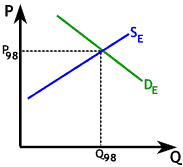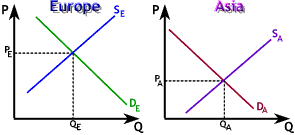
Air fares to Europe are always reduced somewhat in the post-holiday winter months, but this year they are considerably lower than is typical for this time of year. As we will see, changes on both the supply and demand sides of the market explain these lower fares.

We'll use the graph to the right as our starting point. P98 represents an average price for a flight from the U.S. to Europe in the late winter of 1998 and Q98 represents the number of tickets sold during that time. Air fares from the U.S. to Europe are always somewhat lower in late winter because vacation travel is at its lowest during that time period so the demand curve is already shifted back every year for that reason.
It may seem odd at first, but one of the reasons for lower fares to Europe is the economic slowdown that has affected most Asian economies. Initially, as shown to the left, the Asian economic slowdown lead to a reduction in the number of business flights to that part of the world from the U.S.

As the graph to the left shows, the worsening economic situation in most Asian countries lead to a reduction in the demand for business flights to Asia. Reduced demand is shown as a shift back in the demand curve DA causing the price of such flights, PA, to fall.
Over time, reduced demand and falling prices on Asian routes caused the major international airlines to reconsider optimal deployment of their fleet of planes. As we know, if a firm which produces multiple products finds prices falling in one market it services it may, over time, shift resources to another of its markets.

As demand for flights to Asia fell, and as airlines realized the economic woes troubling Asia might not disappear quickly, they moved planes normally used on Asian routes to service customers wishing to fly from the U.S. to Europe. As shown to the right, the supply of flights to Asia fell and the supply of flights to Europe rose.
Demand for flights by tourists to Europe always falls during the first three months of the year, and, even though the European economies haven't been badly hurt by the Asian economic crisis, U.S. firms have cut back on all overseas business travel. Reductions in business flying, combined with the normal seasonal reduction in vacation trips, have lead to a significant reduction in demand for airline tickets to European destinations.

As we learned in our study of Supply and Demand, when both supply increases and demand decreases, market price must fall. In this case the shifting of planes from Asian to European routes, combined with both a normal seasonal reduction and an additional reduction in business flying, have lead to surprisingly low prices for flights from the U.S. to Europe during the next few weeks. Whether the overall number of tickets sold will increase or decrease is indeterminant, though we've shown a slight increase on the graph to the left. In any case, if you've been wanting to fly to Europe, now is a great time, just take along a PowerBook or other laptop and a digital camera and email us photos.
Copyright © 1995-2003 OnLineTexts.com, Inc. - All Rights Reserved